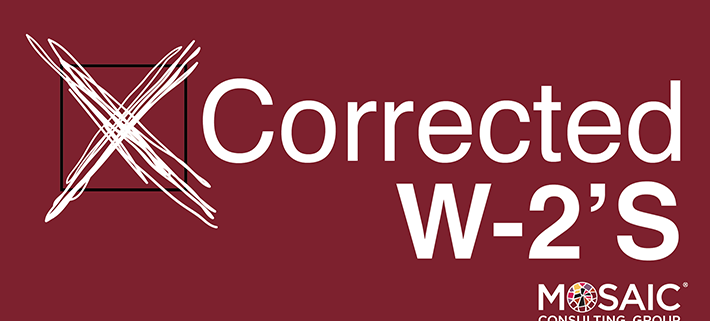When is a Corrected W-2 Necessary?
What is a W-2C?
The short answer: A W-2C is a corrected version of the W-2 form. As simple as that! (not really…)
Most employees will never see a W-2C, but they are needed occasionally. With so much change in 2020 and 2021, let’s explore when they are needed, the information you enter in UKG Pro that will trigger a W-2C, what you need to successfully complete any prior year adjustments, and how to report those changes.
What does a W-2C look like?
Since the purpose of a W-2C form is to correct the information on the W-2 form, other than the employee’s identifying information, the only data on the form will be that which is corrected. For example, if you correct an employee’s State Taxable earnings, the form will show the “old” data and the corrected information for State Taxable earnings, but no other data will be there.
What DOES trigger a W-2C?
- Name changes – Even something as simple as adding a middle initial
- Address changes – Whether or not the change impacts the employee’s taxable wages
- SSN corrections
- Changes to YTD taxable wages OR taxes withheld
While these will all trigger creation of a W-2C, only the last two will require you to do anything about it.
What DOESN’T trigger a W-2C?
Year End 2020 and 2021 were definitely… unprecedented. It’s worth taking a minute to consider what changes or events do NOT trigger the need for a W-2C:
- Catch-up pay cycles – If, for any reason, employees missed pay and your organization needs to run a catch-up pay cycle for wages owed in 2021 (if the catchup pay was completed in 2022) those wages are 2022 wages, and this does not require a W-2C.
- Employer address change – If a company’s (or component company) address changes this will not trigger a W-2C for following year.
- Payroll adjustments – Payroll adjustments that do not change taxable wages or taxes withheld will not trigger a W-2C
- For Example: Moving wages from one earning code to another without changing taxes
As a Payroll Manager, what kind of issues should I be preparing for?
Between when your employees access their W-2 forms and April 15, you will receive phone calls from team members who want changes made to their W-2s. Not every request should be made, nor will it trigger a W-2C, but the most common ones that will require some action on your part are:
- The employee moved mid-year, but taxes were not adjusted.
- State or local wages were not reported in error, either because the location is set up incorrectly, or the employee was marked “exempt” or “block” in error.
- You’ve already made Prior Year adjustments, but they were made after the W-2s were printed.
What do I need to get started with this process?
- With all the changes you need to make for your entire organization, you don’t want to make these changes in small batches. We recommend holding all requested changes until late March to be sure that most, if not all, changes can be made at once.
- Do not try to squeeze these fixes into spare moments throughout a busy week. Block time in your day to dedicate solely to making these changes.
- For each problem you have, you’ll need to know the date the problem started (for example, the first pay date in the new location), and if it was fixed, the date it was fixed.
- Summary Payroll Register for the period(s) needing the corrections.
- A communication plan. Employees should know that a W-2C is coming their way. They should know when the form is expected and what it covers so they can plan accordingly.
- Run reports before you make any changes and again after you have finished.
- Examples include:
- Tax Liability Grand Total – You want this for the entire prior year, and for the 4th quarter of the prior year (this is where all changes will post).
- Wage Detail and W-2 Detail for each employee for the full year.
So, what’s the actual process I need to follow?
- For those cases where an employee’s location was changed late, you can use a Managed Adjustment to “shift” the wages to the correct state. Any over or under-withheld taxes will be moved to a 0NET ADJ code automatically, and then can be refunded to or collected from the employee using that same code.
- If the employee’s location wasn’t changed, you will need to do Standard Adjustments. First, reverse all the impacted checks in the Payroll Gateway. To keep it simple, if there is one check in the middle of the pile that isn’t impacted, reverse that one too. Reversals and adjustments made to the Prior Year will always post to a system created Supplemental Per Control.
- Enter your adjustments. You don’t need one adjustment for each check. Best practice is one adjustment for each quarter. You need to make sure that your net pay remains unchanged, so any over-withheld taxes should either be applied to the employee’s Federal Taxes or placed in the 0NET ADJ deduction for repayment later.
- After posting your adjustments, notify UKG of the changes via the Notify button.
- Once your adjustments are posted, run Tax Recon for the 4th quarter of the prior year. You can run this just for the employees who have had corrections made. Also re-run all the reports that you ran before starting this process and compare them to the “before” reports to verify that the appropriate changes occurred.
- Generate your W-2C forms in UKG Pro.
- If UKG is your Tax Processor, they will file the needed adjustments with the various taxing authorities. If you use another company for tax filing (or if they are done internally), follow those processes for reporting adjustments.




